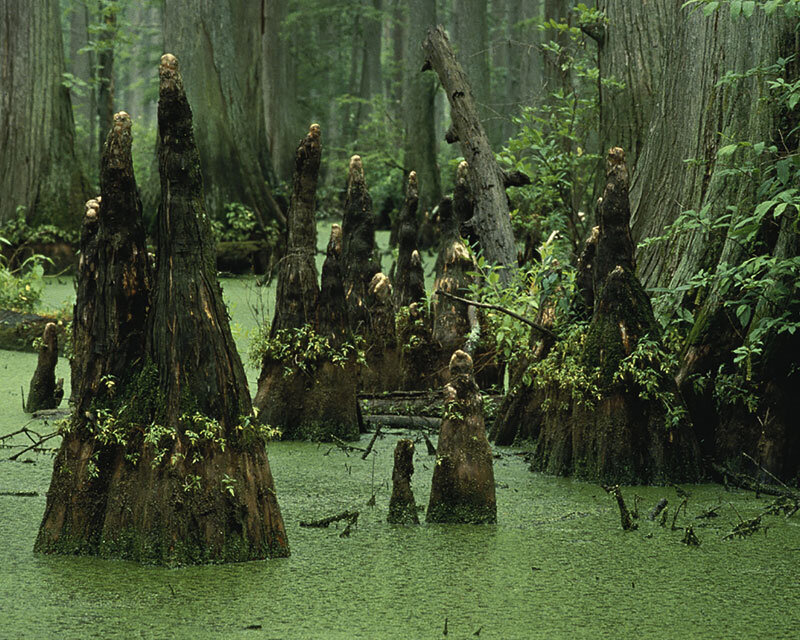A QUIET HISTORY

CROWDED BY GIANT TREES AND VISITED BY GHOSTS AND MONSTERS ALIKE, SKY LAKE IS WHAT EVERY FAIRY TALE IS MADE OF
Sarah Costa thinks there might be some ghosts at Sky Lake. Or so the Oxford resident teasingly tells her toddler son, Brady Tait, as he wanders up and down the Sky Lake Boardwalk one sunny Sunday afternoon in February, telling his mother and her friend Brad Hayden, also of Oxford, that there could be a swamp monster in the water. Costa brushes grass off her jeans, adjusts the small bouquet of violet flowers she picked and follows Tait and Hayden as they head for the edge of the lake. She nods toward the woods where the boardwalk disappears, like the path in a fairy tale.
“There’s some ghosts for sure in here,” she says.
Ghosts or not, there’s certainly history at Sky Lake, off the Mississippi River in the heart of the Delta. A few miles outside Belzoni and alive with birds, insects and everything in between, the area is less than two miles from American Indian mounds and home to some of the world’s oldest cypress trees - what the informational signs at the Sky Lake park entrance calls “living dinosaurs of the Delta.”
Jason May, a biologist with nonprofit Wildlife Mississippi, which helped establish the boardwalk in 2011, says that history is one of the things that makes Sky Lake unique.
“It’s just a unique place,” he said. “There’s not very many areas left that have some of this old grove cypress - some of the oldest and largest trees in the world. They’re kind of like our local version of the giant redwoods.”
The Mississippi Department of Wildlife, Fisheries and Parks set aside the park as a wildlife management area and built the 1,700 foot boardwalk in 2011. It now sees between 3,000 and 5,000 visitors a year, May said, from international tourists to locals on their morning jog.
At the park entrance is a small stone amphitheater and four hollowed-out cypress trunks, along with a small picnic area for events or meals. Visitors can learn more about Sky Lake and the ancient trees by reading informational signs around the park entrance. A walk across the boardwalk takes you about 12 feet over the lake bed. In the winter, May said, you can see wood ducks, songbirds, snakes, turtles and when the water’s clear, fish.
But the “hot item” is the cypress trees, May said. Tree ring biologists, cutting core samples from some of the trees that haven’t become hollow over the centuries, have put some of Sky Lake’s cypress between 800 and 1,000 years old. The hollow ones, May said, may be closer to 2,000. The largest cypress - which measures 46 feet and nine inches in circumference and about 15 feet in diameter - waits at the end of the boardwalk.
“Somehow - it’s a miracle - it’s still alive,” May said.
The more water savvy visitor, equipped with a canoe or kayak, can take one of the parks’ three color-coded loops on the lake’s 2.6-mile paddling trail, which Wildlife Mississippi recommends doing from late fall to early summer, when the water level is highest. One of the loops, May said, takes boats through the shallower waters of the swamp, another takes them out into the open part of the lake and the third meanders more or less along the same route as the boardwalk.
“It gives you a little bit better perspective of how large some of these trees are because you can get right up next to them and paddle amongst all of them,” he said. “It’s pretty neat.”
On this trail, a paddler can glide silently through the water under a canopy of trees, listening to the songbirds and insects and, if lucky, catching a glimpse of a fish or even an alligator at home in the swamp. For May, it’s just another part of what makes Sky Lake a unique place, full of quiet natural history.
“You get to wondering, if you have time to go out there and sit,” May said. “You think, ‘What have these trees seen in their 1,000 - 2,000 years?’”
JAKETOWN MOUNDS
Just down the road from the boardwalk, about halfway to Belzoni, drivers can park at a small pull-off area for a look at the Jaketown Mounds.
One of the earliest Native American earthworks in the state, Jaketown dates to between 1500 and 1350 B.C., when Americans were constructing mounds all over the Southeast. According to the Mississippi Department of Archives and History, these mounds mark centers of social and political authority.
Archaeologists at Jaketown have determined hunter-gatherer tribes in the Late Archaic Poverty Point Period built 18 mounds, three of which you can still see. Visitors can see artifacts uncovered at the site at the Jaketown Museum in downtown Belzoni.
STORY & AMPHITHEATER/JAKETOWN PHOTOS BY ISABELLE ALTMAN
PHOTO COURTESY MISSISSIPPI FISH AND WILDLIFE FOUNDATION










